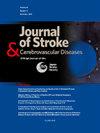社区社会人口特征与卒中护理的适当过渡相关:卒中护理过渡的差异研究
IF 2
4区 医学
Q3 NEUROSCIENCES
Journal of Stroke & Cerebrovascular Diseases
Pub Date : 2025-04-26
DOI:10.1016/j.jstrokecerebrovasdis.2025.108330
引用次数: 0
摘要
目的:不良的社会经济条件与卒中相关死亡率的增加和卒中后临床结果的恶化有关。本研究探讨了急性缺血性脑卒中患者出院一个月后社区社会人口统计学(NSD)特征与适当的护理过渡(ATOC)之间的关系。方法护理转变卒中差异研究(TCSD-S)是一项观察性前瞻性队列研究,旨在调查卒中护理转变的差异。1132例急性缺血性卒中(AIS)患者的数据来自三个来源:1)通过参与者的邮政编码获得的公开的NSD数据,2)出院后30天的结构化电话访谈,以确定参与者在六个类别中的行为,以及3)从Get with the Guidelines-Stroke®(GWTG-S)获得的协变量。Logistic回归模型检验了nsd与实现ATOC之间的关系,ATOC定义为坚持至少75%的ATOC六种行为改变,并根据患者人口统计学、健康的社会决定因素和中风严重程度进行调整。结果样本中56%为男性,51.5%为非西班牙裔白人,22.6%为非西班牙裔黑人,21.8%为西班牙裔个体,中位年龄为64岁(IQR = 55-74岁)。994例(88%)患者达到ATOC。虽然NSD不能独立预测ATOC的总体成功,但我们观察到NSD特征(教育水平和收入中位数)与患者对康复随访的依从性(p = 0.03)、有毒习惯的戒除(p = 0.04)和医疗预约出勤率(p = 0.04)直接相关,独立于个人社会经济地位的影响。结论社区社会经济地位直接影响保护行为。这一发现可以为未来社区层面的干预提供信息,旨在提高患者对行为改变的依从性。本文章由计算机程序翻译,如有差异,请以英文原文为准。
Neighborhood socio-demographic profile associated with adequate transitions of stroke care: The transitions of care stroke disparities study
Objective
Poor socioeconomic conditions are linked to increased stroke-related mortality and worse clinical outcomes post-stroke. This study examines the association between neighborhood socio-demographic (NSD) profile and adequate transitions of care (ATOC) in acute ischemic stroke patients one month after discharge.
Methods
The Transitions of Care Stroke Disparities Study (TCSD-S) is an observational prospective cohort investigating disparities in stroke care transitions. Data from 1132 acute ischemic stroke (AIS) patients was obtained from three sources: 1) publicly available NSD data using participants’ ZIP codes, 2) Structured telephone interviews at 30 days post-discharge to ascertain participants’ behavior in six categories, and 3) covariates obtained from Get with the Guidelines-Stroke® (GWTG-S). Logistic regression models examined the relationship between NSDs and achieving ATOC, defined as adherence to at least 75 % of the six behavioral modifications for ATOC, adjusting for patient demographics, social determinants of health, and stroke severity.
Results
The sample included 56 % males, 51.5 % non-Hispanic White, 22.6 % non-Hispanic Black, and 21.8 % Hispanic individuals, with a median age of 64 (IQR = 55-74 years). ATOC was achieved in 994 (88 %) participants. While NSDs did not independently predict the overall ATOC success, we observed a direct association of NSD profile (education level and median income) with patients’ adherence to rehabilitation follow-up (p = 0.03), toxic habit cessation (p = 0.04), and medical appointment attendance (p = 0.04), independent of the effects of individual socioeconomic status.
Conclusions
Neighborhood socioeconomic status directly impacts protective behaviors. This finding can inform future community-level interventions aimed at improving patients' adherence to behavioral modifications.
求助全文
通过发布文献求助,成功后即可免费获取论文全文。
去求助
来源期刊

Journal of Stroke & Cerebrovascular Diseases
Medicine-Surgery
CiteScore
5.00
自引率
4.00%
发文量
583
审稿时长
62 days
期刊介绍:
The Journal of Stroke & Cerebrovascular Diseases publishes original papers on basic and clinical science related to the fields of stroke and cerebrovascular diseases. The Journal also features review articles, controversies, methods and technical notes, selected case reports and other original articles of special nature. Its editorial mission is to focus on prevention and repair of cerebrovascular disease. Clinical papers emphasize medical and surgical aspects of stroke, clinical trials and design, epidemiology, stroke care delivery systems and outcomes, imaging sciences and rehabilitation of stroke. The Journal will be of special interest to specialists involved in caring for patients with cerebrovascular disease, including neurologists, neurosurgeons and cardiologists.
 求助内容:
求助内容: 应助结果提醒方式:
应助结果提醒方式:


